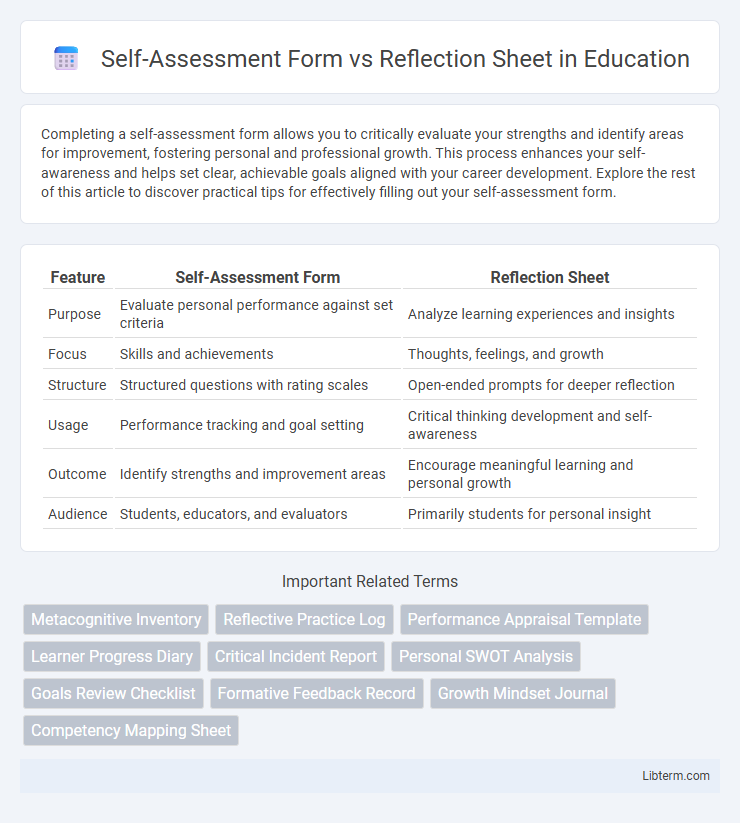Completing a self-assessment form allows you to critically evaluate your strengths and identify areas for improvement, fostering personal and professional growth. This process enhances your self-awareness and helps set clear, achievable goals aligned with your career development. Explore the rest of this article to discover practical tips for effectively filling out your self-assessment form.
Table of Comparison
| Feature | Self-Assessment Form | Reflection Sheet |
|---|---|---|
| Purpose | Evaluate personal performance against set criteria | Analyze learning experiences and insights |
| Focus | Skills and achievements | Thoughts, feelings, and growth |
| Structure | Structured questions with rating scales | Open-ended prompts for deeper reflection |
| Usage | Performance tracking and goal setting | Critical thinking development and self-awareness |
| Outcome | Identify strengths and improvement areas | Encourage meaningful learning and personal growth |
| Audience | Students, educators, and evaluators | Primarily students for personal insight |
Introduction to Self-Assessment Forms and Reflection Sheets
Self-assessment forms and reflection sheets serve as essential tools for personal and academic growth by encouraging individuals to evaluate their own performance and experiences. Self-assessment forms typically provide structured criteria to measure specific skills or achievements, facilitating objective evaluation. Reflection sheets focus more on thoughtful introspection, allowing individuals to explore their thoughts, feelings, and learning processes in a narrative format.
Defining Self-Assessment Forms
Self-assessment forms are structured tools designed to help individuals evaluate their own performance, skills, and learning progress against set criteria or objectives. These forms often include specific questions or rating scales that guide the individual to critically analyze strengths, weaknesses, and areas for improvement. Unlike reflection sheets, which emphasize personal insights and emotional responses, self-assessment forms prioritize measurable outcomes and goal-oriented evaluation.
Understanding Reflection Sheets
Reflection sheets serve as structured tools designed to guide individuals through a process of critical thinking about their learning experiences, encouraging deeper self-awareness and insight. Unlike self-assessment forms that primarily quantify performance based on predetermined criteria, reflection sheets emphasize qualitative analysis and personal growth by prompting detailed responses about feelings, challenges, and lessons learned. Understanding reflection sheets involves recognizing their role in fostering metacognition and continuous improvement through meaningful introspection.
Purpose and Objectives: A Comparative Overview
Self-assessment forms primarily serve to evaluate personal performance against predefined criteria, promoting self-awareness and goal-setting through structured feedback. Reflection sheets focus on introspective analysis, encouraging individuals to explore experiences, emotions, and learning processes for deeper personal growth. Both tools aim to enhance self-improvement, yet self-assessment forms emphasize measurable outcomes while reflection sheets prioritize subjective insights.
Key Components of Self-Assessment Forms
Self-Assessment Forms primarily include key components such as goal setting, performance evaluation, and skill gap analysis to help individuals critically appraise their achievements and areas for improvement. These forms often require specific examples and measurable outcomes to support self-reflection and facilitate actionable development plans. In contrast, Reflection Sheets focus more on personal insights and emotional responses, making Self-Assessment Forms essential for structured, objective performance reviews and professional growth tracking.
Essential Elements in Reflection Sheets
Reflection sheets emphasize essential elements such as personal insights, emotional responses, and learning outcomes, enabling learners to critically evaluate their experiences and growth. Unlike self-assessment forms that focus primarily on rating performance against set criteria, reflection sheets require deeper cognitive engagement and articulation of lessons learned. Key components include identifying strengths and weaknesses, setting future goals, and connecting theoretical knowledge with practical application.
Benefits of Using Self-Assessment Forms
Self-assessment forms empower individuals to critically evaluate their skills, progress, and areas for improvement, fostering personal accountability and targeted development. These forms provide structured feedback that enhances self-awareness and supports goal-setting aligned with performance standards. Using self-assessment forms promotes continuous learning by encouraging consistent reflection on achievements and challenges within a measurable framework.
Advantages of Incorporating Reflection Sheets
Incorporating reflection sheets enhances the depth of student learning by encouraging critical thinking and personal insight beyond the factual evaluation provided by self-assessment forms. Reflection sheets facilitate metacognitive skills, enabling learners to identify strengths, weaknesses, and areas for growth, thereby promoting continuous improvement. This qualitative approach complements quantitative self-assessment, offering a comprehensive understanding of individual progress and fostering long-term academic development.
When to Use: Self-Assessment Form vs Reflection Sheet
Use a Self-Assessment Form to evaluate specific skills, accomplishments, or performance criteria at regular intervals such as quarterly reviews or project completions. A Reflection Sheet is most effective after significant experiences or learning activities to encourage deeper personal insight and critical thinking about challenges and growth. Choosing between the two depends on whether the goal is to measure objective outcomes or to foster subjective understanding and self-awareness.
Choosing the Best Tool for Personal Growth
Self-assessment forms provide structured, quantitative feedback that highlights specific skills and areas for improvement, making them ideal for tracking measurable progress. Reflection sheets encourage deeper introspection and emotional insight, fostering personal growth through thoughtful analysis of experiences and feelings. Choosing the best tool depends on whether you seek objective evaluation or meaningful self-reflection to guide your development journey.
Self-Assessment Form Infographic

 libterm.com
libterm.com